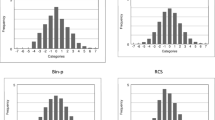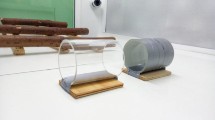Abstract
Examination of the effect of three doses of pentobarbital on the comparative performance of a complex psychomotor taks with two simple neuromotor tasks, i.e., standing steady and pendulum eye tracking, revealed a high correlation. These simple tasks could be used as measures of intoxication since they do not require extensive training. Examination of the complex task impairment blood level ratio revealed that impairment relative to blood level was much greater in the absorption phase. This changing ratio underscores the point that blood levels alone are not an adequate estimate of intoxication.
Similar content being viewed by others
References
Adams AJ, Brown B, Flom MC, Jampolsky A, Jones RT (1977) Influence of socially used drugs on vision and vision performance. In: Holloway H (ed) Use and abuse of social drugs. Agrd Conf Proceedings 218, C51–C59
Barr AJ, Goodnight JH, Sall JP, Blair WH, Chilko DM (1979) SAS User's Guide, 1979 edn. Helwig JT, Council KA (eds) SAS Institute, Cary, N. C. p 237
Begbie GH (1966) The effects of alcohol and varying amounts of visual information on a balancing task. Ergonomics 9:325–333
Bender MB, O'Brien FH (1946) The influence of barbiturate on various forms of nystagmus. Am J Opthalmol 29:1541–1552
Bergman PS, Nathanson M, Bender MB (1952) Electrical recording of normal and abnormal eye movements modified by drugs. Arch Neurol 67:357–374
Brown B (1972) Dynamic visual acuity eye movements and peripheral acuity for moving targets, Vision Res 12:305–331
Burg A (1968) Vision test scores and driving record: Additional findings. Department of Engineering II, University of California Report No 68-27
Burg A (1974) Visual degradation in relation of specific accident types. Final Report, Institute of Transportation and Traffic Engineering. School of Engineering and Applied Science, University of California in Los Angeles (UCLA-Eng-7419)
Collins WF, Gilson RD, Schroeder DJ, Guedry FE (1971) Effects of alcohol ingestion on tracking performance during angular acceleration. J Appl Psychol 55:559–563
Forney RB, Hughes FW, Harger RN, Richards AB (1964) Alcohol distribution in the vascular system concentration of orally administered alcohol in blood from various points in the vascular system and in rebreathed air during absorption. Q J Stud Alc 25:205–217
Gilson RD, Schroeder DJ, Collins WE, Guedry FE (1972) Effects of different alcohol dosages and display illumination on tracking performance during vestibular stimulation. Aero Med 43:656–660
Goldberg L (1943) Quantitative studies on alcohol tolerance in man, the influence of ethyl alcohol on sensory, motor and psychological functions referred to blood alcohol in normal and habituated individuals. Acta Physiol Scand Suppl No 16:7–128
Goldberg L (1966) Behavioral and physiological effects of acohol on man. Psychosom Med 28:570–595
Grizzle JE, Allen DM (1969) Analysis of growth and dose-response curves. Biometrics 25:357–381
Hakkinen S (1958) Traffic accidents and driver characteristics. Tekmillinnen Korkeakoulu, Helsinki
Hakkinen S (1976) Traffic accidents and psychomotor test performance: a follow-up study. Mattila MJ (ed) Mod Probl Pharmacopsychiatry 11:51–61
Harvey SC (1980) Hypnotics and sedatives. In: Gilman AG, Goodman LS, Gilman A (eds) The pharmacological basis of therapeutics. McMillan Publishing, New York, p 339
Holzman PS, Levy DL (1977) Smooth pursuit eye movements and functional psychosis: A review. Schizophr Bull 3:15–27
Hurst PM, Bagley SK (1972) Acute adaptation to the effects of alcohol. Q J Stud Alc 33:358–378
Korttila K, Linnoila M (1974) Skills related to driving after intravenous diazepam, flunitrazepam or droperidol. Br J Anaesth 46:962–969
Kuechenmeister CA, Linton PH, Mueller TV, White HB (1977) Eye tracking in relation to age, sex and illness. Arch Gen Psychiatry 34:578–579
LeBlanc AE, Kalant H, Gibbins RJ (1975) Acute tolerance to ethanol in the rat. Psychopharmacologia 41:43–46
Lindsey DT, Holzman PS, Haberman S, Yasillo NJ (1978) Smoothpursuit eye movements: a comparison of two measurement techniques for studying schizophrenia. J Abnorm Psychol 87:491–496
Linnoila M, Otterstrom S, Mattila M (1974) Serum chlordiazepoxide, diazepam and thioridazine concentrations after simultaneous ingestion of alcohol and placebo drink. Ann Clin Res 6:4–6
Miller GE (1975) Aging and extraocular muscles. In: Basic mechanisms of ocular motility and their clinical implications. Pergamon Press, Oxford, p 47
Morrison DF (1976) Multivariate statistical methods. McGraw-Hill, New York
Moskowitz H, Sharma S (1974) Effects of alcohol on peripheral vision as a function of attention. Hum Factors 16:174–180
Norris H (1968) The time course of barbiturate action in man investigated by the measurement of smooth tracking eye movement. Br J Chemother 33:117–128
Orr J, Dussault P, Chappel C, Goldberg L, Reggiani G (1976) Relationship between drug induced central nervous system effects and plasma levels of diazepam in man. Mod Probl Pharmacopsychiatry 11:57–67
Rashbass C, Russell GFN (1961) Action of a barbiturate drug (amylobarbitone sodium) on the vestibulo-oculo reflex. Brain 84:329–335
Shagass C (1957) A measurable neurophysiological factor of psychiatric significance. EEG and Clin Neurophysiol 9:101–108
Schroeder DJ, Collins WE (1974) Ergonomics 17:613–621
Schroeder DJ, Gilson RD, Guedry FE, Collins WE (1973) Effects of alcohol on nystagmus and tracking performance during laboratory angular acceleration about the Y and Z axis. Aero Med 44:477–483
Wilson AS, Barboriak JJ, Kass WA (1970) Effects of alcoholic beverages and congeners on psychomotor skills in old and young subjects. Q J Stud Alc Suppl 45:115–129
Author information
Authors and Affiliations
Rights and permissions
About this article
Cite this article
Ellinwood, E.H., Linnoila, M., Angle, H.V. et al. Use of simple tasks to test for impairment of complex skills by a sedative. Psychopharmacology 73, 350–354 (1981). https://doi.org/10.1007/BF00426464
Received:
Accepted:
Issue Date:
DOI: https://doi.org/10.1007/BF00426464




